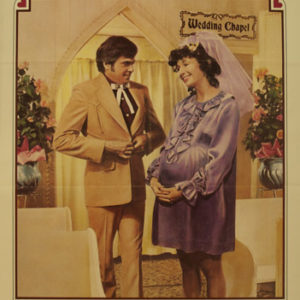calsfoundation@cals.org
Mary Nell Steenburgen (1953–)
Mary Nell Steenburgen is one of Arkansas’s most celebrated actors. Noted for roles in cinema, television, and stage, she has portrayed a wide range of characters, from the president’s mother, Hannah Nixon, in Nixon (1995) to schoolteacher Clara Clayton in Back to the Future III (1990) and seductress Betty Carver in What’s Eating Gilbert Grape (1993). She has won many awards, including an Academy Award for her portrayal of Lynda Dummar in Melvin and Howard (1980).
Mary Steenburgen was born on February 8, 1953, in Newport (Jackson County) to Maurice Steenburgen, a freight train conductor, and Nellie Mae Wall Steenburgen, a school secretary. Her family—including a younger sister, Nancy Lynn—moved to North Little Rock (Pulaski County) when she was three because of her father’s railroad job. Steenburgen’s mother enrolled her in dance lessons, and when she was four, Steenburgen danced for hospitalized veterans at Fort Roots Hospital and on local television programs.
One of the first stage productions Steenburgen saw was The Music Man, performed at the Robinson Center Auditorium in Little Rock (Pulaski County) when she was eight. A voracious reader, Steenburgen often acted out scenes from books or movies alone or with friends. Her first appearance on stage was as a high school senior in North Little Rock’s Northeast High School in which she portrayed Emily in Our Town. She also was involved in the North Little Rock Community Theater’s production of The Crucible, and Steenburgen wrote and directed a play based on the Broadway musical Godspell for her church youth group.
After her high school graduation in 1971, Steenburgen enrolled in the drama department at Hendrix College in Conway (Faulkner County). Encouraged by her drama teacher to develop her acting skills further, she visited Dallas after her freshman year, where she auditioned for and won a coveted slot at Sanford Meisner’s Neighborhood Playhouse. As a result, she moved to New York when she was nineteen.
The Playhouse, a school for aspiring actors, taught Steenburgen how to act honestly under imaginary experiences. Steenburgen worked at a bookstore but left the job after discovering that she was spending her entire salary on books. She then worked as a waitress in a crêpe restaurant. With four of her classmates, she founded an improvisational comedy group called the Cracked Tokens, which eventually performed regularly at the Manhattan Theatre; prior to that success, they performed at halfway houses for recovering alcoholics and drug addicts.
A CBS television talent scout told her about an upcoming audition for a new Jack Nicholson movie. Steenburgen went to the audition (which was intended only for name actresses), and Nicholson singled her out in the waiting room, provided her with a script, and arranged for her first audition; thus her first film role, in Goin’ South (1978). She played Julia Tate, who married Henry Moon (Nicholson’s character) to prevent him from being hanged. Although the film received little acclaim, Steenburgen was highly praised for her role and received a Golden Globe nomination.
She then starred in the time-travel romantic comedy Time after Time in 1979, during the filming of which she met her future husband, British actor Malcolm McDowell. Again, Steenburgen received more positive attention than the film in which she acted. She married McDowell on September 29, 1980; they had two children: actress Lilly McDowell and producer/director Charlie McDowell.
Steenburgen’s performance in her third film, Melvin and Howard (1980), featured an enthusiastic tap-dancing number by her character, Lynda Dummar. She won the Academy Award for Best Actress in a Supporting Role for this movie. In Cross Creek (1983), Steenburgen played Marjorie Kinnan Rawlings, author of The Yearling. Her husband appeared in the film as Rawlings’s editor, Max Perkins.
After 1983, Steenburgen took some time off from making movies, living much of the time in London. While there in 1987, she made her London stage debut, co-starring with McDowell in Philip Barrie’s Holiday at the Old Vic Theatre. She continued her work on the stage and starred in the title role in Candida in her Broadway debut in 1993.
Meanwhile, Steenburgen’s love of railroaders found a voice in End of the Line (1987). She said the experience with the movie, which paid homage the plight of the railroad worker, was “deeply, deeply personal,” because of her father’s career in the railroad industry. Wilford Brimley and Arkansas-born actor-singer Levon Helm played the film’s heroic figures attempting to save their railroad from closure. Steenburgen was executive producer of the film and played the part of Rose Pickett. North Little Rock native Jay Russell, also the child of a railroader, wrote and directed the film, which was shot in Benton (Saline County), Little Rock, North Little Rock, Lonoke (Lonoke County), Scott (Pulaski and Lonoke Counties), Pine Bluff (Jefferson County), and Chicago, Illinois. Russell’s and Steenburgen’s fathers appeared in the opening scenes as extras. The movie was not highly rated by critics.
Steenburgen’s father died while she was filming Parenthood (1989). She and McDowell divorced in 1989 in a manner she later described as “amicable.”
Steenburgen played the love interest for the scientist “Doc” Emmett L. Brown in her second time-travel film, Back to the Future III (1990). In The Butcher’s Wife (1991), she sang cabaret renditions of Bessie Smith’s “In the Dark” and Irving Berlin’s “What’ll I Do.”
Steenburgen appeared in thirty films from 1978 until 1991, after which she took nine months off to campaign for her friend, Governor Bill Clinton, in his 1992 bid for president. Clinton had become friends with Steenburgen’s family after he commented on her success during a speech given to retired railroad workers in 1978, when he was first running for governor. Steenburgen’s father was in the audience and, upon meeting the candidate, insisted that Clinton needed to meet his daughter if he was going to use her story in his campaign. Steenburgen proved a tireless campaigner, was a delegate to the Democratic National Convention, and became a confidante to Clinton. She has remained involved in political campaigns, supporting the Clintons and General Wesley Clark and also speaking on women’s issues.
In What’s Eating Gilbert Grape (1993), Steenburgen played a frustrated housewife who seduced young Johnny Depp’s character. It became a cult favorite. In It Runs in the Family (1994), also known as My Summer Story, a sequel to Jean Shepherd’s 1983 classic A Christmas Story, Steenburgen took over the role of the understanding mother, which was originated by Melinda Dillon of Hope (Hempstead County). Among her other notable roles in feature films, she is remembered as Belinda Conine in Philadelphia (1993), Hannah Nixon in Nixon (1995), and Emily in Elf (2003).
On October 7, 1995, Steenburgen married actor Ted Danson at their home in Martha’s Vineyard. They had met when he had auditioned unsuccessfully for a part in Cross Creek, and they later worked together in the movie Pontiac Moon (1994). They starred in the television miniseries Gulliver’s Travels (1996) and Living with the Dead (2002) and were executive producers of their television series Ink (1996). Steenburgen and Danson share a love of art. Danson is a sculptor, and she is a painter.
About Sarah (1998), with Steenburgen appearing as a mentally challenged mother, earned her a Screen Actors Guild nomination for Best Actress in a Miniseries. Steenburgen returned to a television series in 2003 to play the title character’s mother in Joan of Arcadia (2003–2005). She has continued to appear regularly on television and in movies, including the television shows Curb Your Enthusiasm, Bored to Death, 30 Rock, Justified, Orange Is the New Black, and The Last Man on Earth, and movies Step Brothers (2008), Four Christmases (2008), The Proposal (2009), The Help (2011), Last Vegas (2013), and Book Club (2018). She has also done voice work for animated films, such as the English-language version of The Tale of Princess Kaguya (2013). In 2009, she received a star on the Hollywood Walk of Fame.
Steenburgen has maintained her ties with Arkansas and has advocated for a number of causes and organizations, including the Arkansas Children’s Hospital, where she had volunteered as a teenager; the Elizabeth Glaser Pediatric AIDS Foundation; the Arkansas Repertory Theatre; the Thea Foundation; Blackbird Academy of Arts; and Heifer International. On the national level, she is involved with the American Oceans Campaign, Artists for a Free South Africa, and Amnesty International. In 2006, she received an honorary Doctor of Humane Letters from Lyon College in Batesville (Independence County).
She and Danson maintain homes in Los Angeles, Martha’s Vineyard, and Little Rock. She also has a home in Nashville, Tennessee, and began working with Universal Music Publishing Group after becoming intensely involved in musical pursuits, including songwriting, following a medical procedure in 2009. Among many other songs, she co-wrote the power ballad “Glasgow” that actor Jessie Buckley performs at the end of the 2018 movie Wild Rose.
Steenburgen appeared in the Hulu movie The Happiest Season in 2020, and that same year began the role as Zoey’s mother in the NBC television show Zoey’s Extraordinary Playlist.
For additional information:
Ehrlich, David. “The Wild Story of How Mary Steenburgen Wrote the Best Original Movie Song of the Year.” IndieWire, November 13, 2019. https://www.indiewire.com/2019/11/mary-steenburgen-jessie-buckley-wild-rose-glasgow-best-original-song-1202189233/ (accessed August 30, 2022).
Esrey, Susan Enfield. “Star Power: How a Cause Grabbed Hold of These Celebs—and Changed Their Lives.” Delicious Living, March 2007, 28–30.
Fleishman, Jeffrey. “Mary Steenburgen Knows How to Coax a Laugh but Is Equally at Home with the Dark Side.” Los Angeles Times, May 11, 2018. Online at http://www.latimes.com/entertainment/movies/la-ca-mary-steenburgen-20180511-story.html (accessed August 30, 2022).
Harris, Will. “Mary Steenburgen on The Last Man on Earth, Her Lucky Break, and Falling for Ted Danson.” The A.V. Club, March 10, 2016. http://www.avclub.com/article/mary-steenburgen-last-man-earth-her-lucky-break-an-233125 (accessed August 30, 2022).
Kart, Lawrence. “Mary Steenburgen: Arkansan on Her Way to Success.” Arkansas Gazette, November 22, 1981, 11F.
Martin, Karen. “Mary Steenburgen.” Arkansas Democrat-Gazette, May 17, 2015, p. 2H.
“Mary Steenburgen.” Internet Movie Database. http://www.imdb.com/name/nm0005460 (accessed August 30, 2022).
Millar, Lindsey. “Mary Does It All.” Arkansas Times, May 14, 2015, pp. 26, 35. Online at http://www.arktimes.com/arkansas/mary-steenburgen-on-being-busier-than-ever-and-her-love-for-arkansas/Content?oid=3850231 (accessed August 30, 2022).
Myers, Marc. “An Encounter With Jack Nicholson Led to Mary Steenburgen’s Big Break.” Wall Street Journal, January 12, 2021. https://www.wsj.com/articles/an-encounter-with-jack-nicholson-led-to-mary-steenburgens-big-break-11610472618?mod=hp_listc_pos4 (accessed August 30, 2022).
Morrison, Mark. “Proud Mary.” In Style, November 2004, 416–421.
Patterson, Ralph B. “No Pumpkinitis Yet for Mary Steenburgen.” Arkansas Gazette, November 2, 1979, pp. 1B, 7B.
Jan Emberton
Little Rock, Arkansas
Staff of the CALS Encyclopedia of Arkansas
 Arkansas Entertainers Hall of Fame
Arkansas Entertainers Hall of Fame Arts, Culture, and Entertainment
Arts, Culture, and Entertainment Melvin and Howard
Melvin and Howard  Mary Steenburgen
Mary Steenburgen  Mary Steenburgen
Mary Steenburgen 




Comments
No comments on this entry yet.